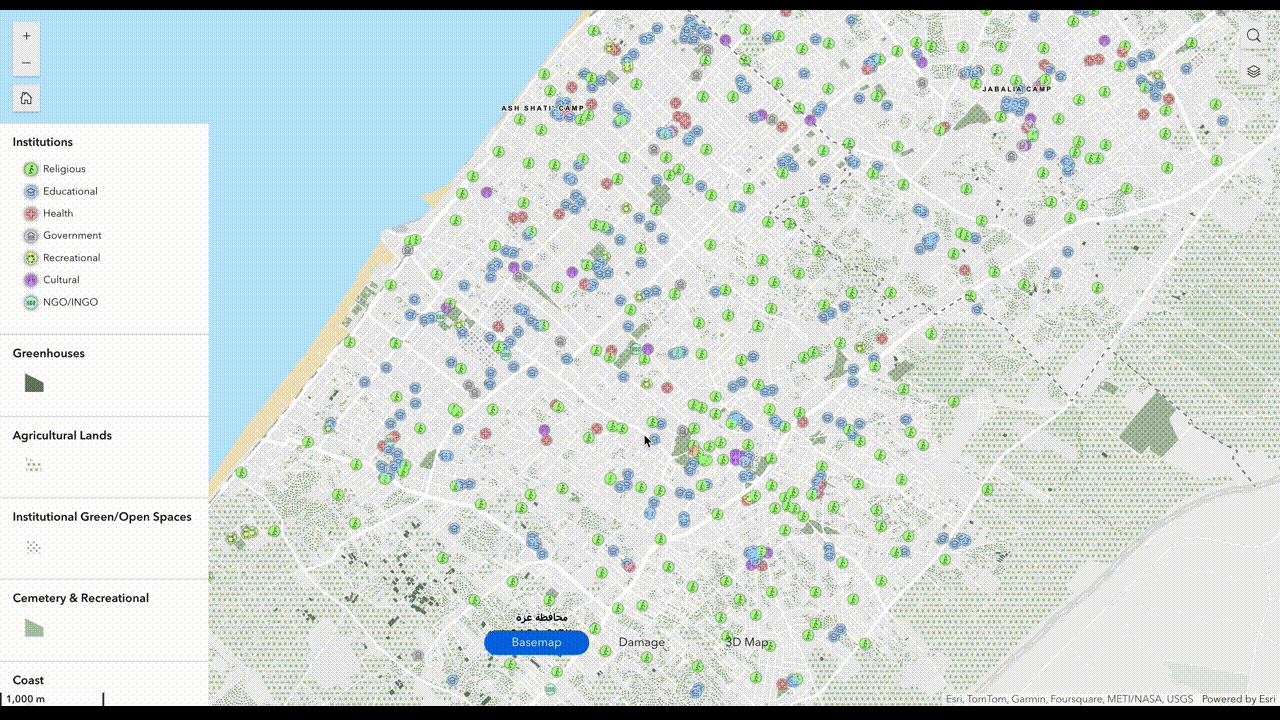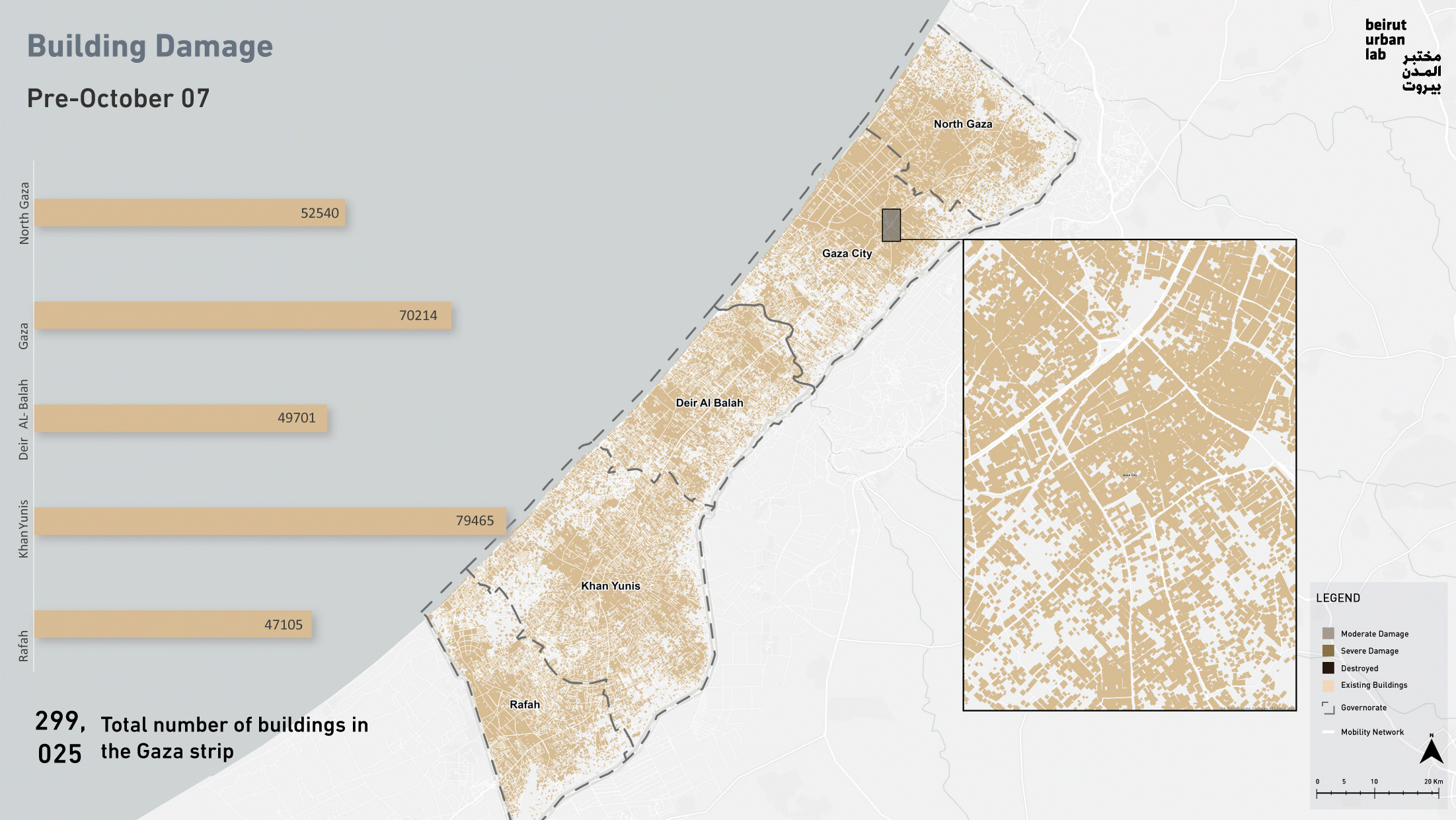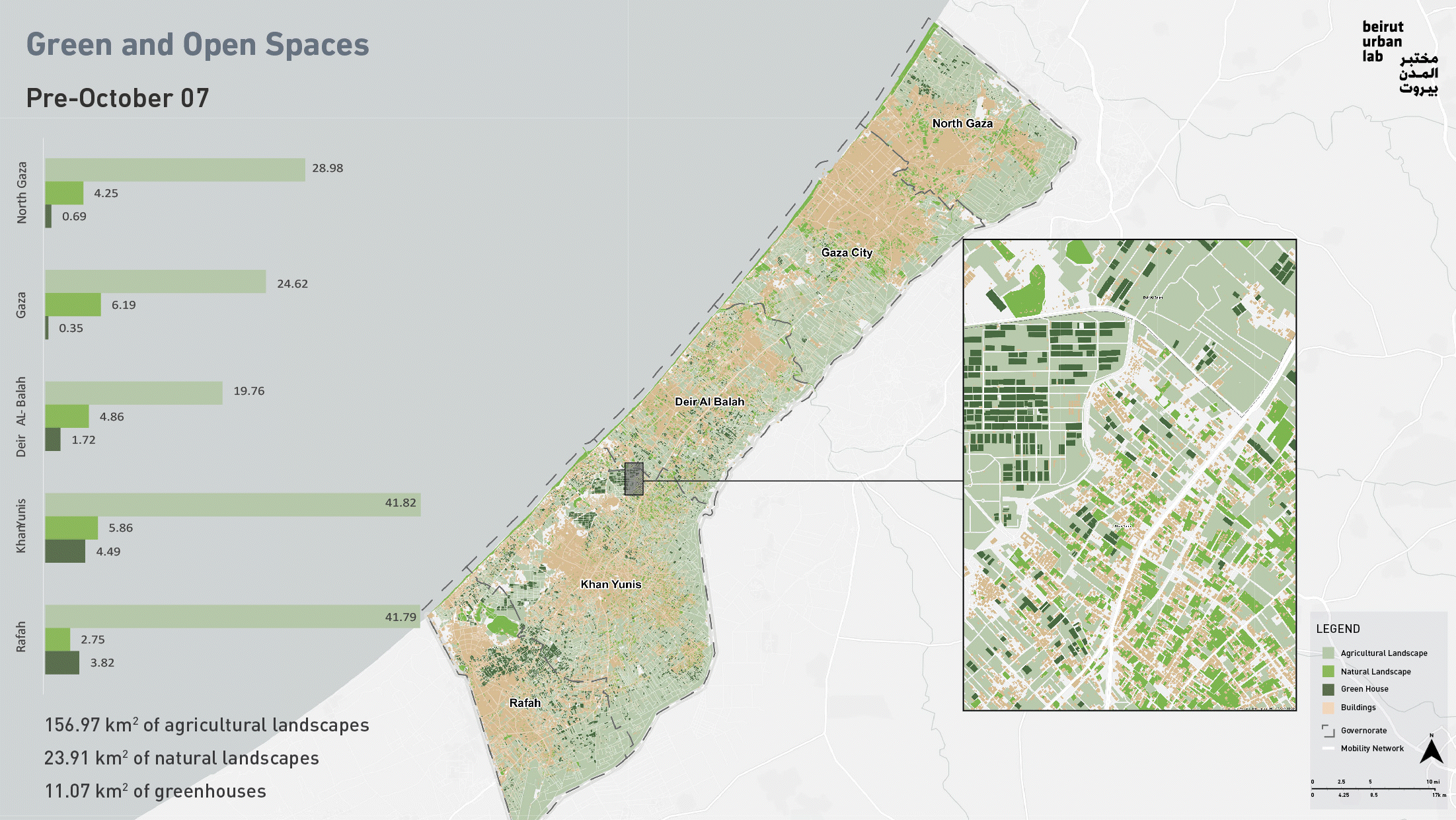Tracking the Urbicide in Gaza

The Context
Urbicide, as argued by Martin Cowardi, encompasses not only the physical destruction of buildings and infrastructure but also the resulting disruption of social and cultural networks, the displacement of populations, and the erasure of collective memory. The urban in this project is therefore understood as an all-encompassing, multilayered, and connected construct. In the case of Gaza, violence against the built environment is not a by-product of military action, rather urbicide manifests as a deliberate strategy employed by Israel to undermine the livelihood, the development, and the culture of the Palestinian people.Gaza is a constructed "strip" that has been built since 1948 as an "exceptional" Palestinian territory which was controlled by the Egyptians and then the Israelis. The "strip" has merged historical cities with camps and agricultural lands around them into a spatial enclave where Israelis have confined many Palestinians. The densely populated urban environment of Gaza, including major cities and eight refugee camps, the largest of which is Jabalia, becomes both a battleground and a target where civilian infrastructure and residential neighborhoods bear the brunt of violence. However, the unfolding urbicide in Gaza is not an isolated event that commenced on October 7th. It is a severe eruption in the context of an unrelenting history of violence that has subjected Gaza to military occupation, blockade, siege, and repeated episodes of military rampage each of which has sought to squeeze life out of its civilian populations.
For over a year of war, the densely populated Gaza, which stretches over 365 km2 with a population of 2.3 million, witnessed devastating military operations, leaving entire neighborhoods reduced to rubble and countless lives shattered. From airstrikes targeting residential buildings to artillery shelling tearing through streets, the urbicide in Gaza has inflicted immense suffering, exacerbated humanitarian crises, and displaced hundreds of thousands of families. At least 43,603 people have been killedii, and nearly 90% of the population has been displacediii. By September 6, 49.6% of total structures in the Gaza strip were damaged with 48,722 structures destroyed, 18,159 severely damaged, 54,533 moderately damaged, and 26,490 possibly damaged.
Those numbers show a massive increase in the total number of structures destroyed or severely damaged (66,881) compared to that in the sum of all four Israeli military operations between 2008 and 2021 (10,326)iv, knowing that each of the previous campaigns was already globally denounced for the severity of the damage it inflicted on people and buildings. Gaza has thus been subjected to exceptionally violent and deadly assaults by the Israeli military. The campaign has systematically destroyed critical infrastructure such as schools, hospitals, archaeological sites to state archives, and even greenhouses. It has unmistakably embarked on a campaign of urbicide, a planned act of erasure and assault on the urban environment and all that it embodies: a sense of collective identity, community, and culture.Dr. Awni Etaywe, of Charles Darwin University, has referred to Israel’s military offensive in Gaza as an act of 'geno-urbicide', which involves both systematic genocidal acts and the intentional destruction of cities, resulting in significant loss of life and the devastation of urban landscapesv.
The Content
This platform is work in progress which the Gaza Working Group at the Beirut Urban Lab aims to build on. The intention is to go beyond the tracking of destruction of the built environment to the tracking of displacement and the analysis of long-term impacts on recovery.
At the moment, it is a mapping project that tracks urbicide and documents damage to different layers of the built environment including: buildings, green/open spaces, institutions such as universities, schools, hospitals, governmental buildings, as well as agricultural lands and infrastructure. The tracking documents damage at different moments in time from October 7th onwards with short intervals. The mapping intends to serve as an archival record of the massive violence inflicted on the cultural, educational, infrastructural and environmental constitution of Gaza. In addition to that, the platform also includes a people-centered thematic recording of the ongoing ‘urbicide’, highlighted under three themes: disruption of socio-spatial practices, displacement, and everyday resistance.
Methodology and Significance
This work started with constructing an updated base map that is georeferenced based on building footprints that predates the October 7 events. This is the first unique contribution of the project as all the released base maps were outdated. To build the digital 2D base map and 3D model, extensive work was undertaken to consolidate data available from multiple sources, to cross-reference, verify, and update it to the conditions prior to October 2023. Sources included Open Street Maps, Microsoft footprints, satellite images of different dates, and a 3D model by VISICOM. The verification process was undertaken manually, verifying building-by-building across multiple sources covering 299,024 buildings. The update included adding or editing 174,360 building footprints and deleting 24,947 buildings in the consolidated map generated from the available sources. Additional data was gathered from various sources to identify institutions, infrastructural utilities, as well as heritage and archeological sites. The source for the initial data on schools and universities was obtained from OCHA and that for heritage and archeological sites was obtained from Riwaq. Data on infrastructural facilities was gathered from a mapping conducted by OCHA in September 2023. The data was then filtered, updated, and cross-referenced using Open Street Maps, Google Earth, and other media sources. The team was able to map 1400 institutions including educational, religious, health, cultural, government, recreational, and NGO/INGO facilities in addition to 208 infrastructural facilities including water desalination plants, waste water facilities, pumping stations, water towers, detention ponds, power plant, port, and gas stations. The team will continue to add to the list of institutions as the work progresses and access to more resources is granted. The 3D model by VISICOM was also updated with the same additions and emissions as the 2D base map. The buildings that were added after the verification process were given a default height of 3 meters knowing that the vast majority of these buildings constitute service units for agricultural lands existing within the buffer zone from the demarcation line.
The second contribution of this project was adding alayer of green and open spaces to the base map and tracking of damage that followed. This layer was not found in any of the existing released assessments and maps for Gaza. The layer was created by analyzing satellite images and identifying patterns of landscapes that were categorized into natural landscapes, institutional landscapes, and agricultural landscapes. The natural landscapes include: 1) riparian: the area that constitutes the interface between a river/stream and land, 2) coastal: the land adjoining the sea, 3) scrubland: the land consisting of scattered vegetation, usually including a selection of shrubs and wild species. The institutional landscapes include: 1) educational: open spaces around schools, universities, and other educational centers, 2) religious: open spaces around mosques and churches, mostly used for gathering, 3) recreational: parks, community spaces, cornice, and playgrounds, 4) health: open spaces around hospitals, mostly open plaza and parking spaces, 5) governmental: open spaces around governmental buildings, mostly vacant, 6) cemeteries: large burial spaces with tombs scattered in an irregular manner. Agricultural landscapes constitute the gridded arable spaces as identified from the satellite images. Green houses were also drawn unit per unit relying on the available satellite images.
The third unique contribution was showing the damage on the building footprint scale in relation to other representations of damage in Gaza. This was done by overlaying the damage data sets with our updated building and open spaces footprints. The main data source used for tracking damage to the built fabric was the georeferenced data base of damage by UNOSAT, which was provided for the following dates: 15 October, 7 November, 26 November, 7 January, 29 February, 1 April, 3 May, 6 July, and 6 September. In addition, damage to the road network in the strip was visualized building on an assessment of damages as of 18 August conducted by UNOSAT too. This layer was added to the infrastructural facilities latest update on the platform. The same data source was used to track damages to open/green spaces but was provided for the following dates: 27 October, 11 November, 11 December, 30 January, 24 April, 28 June, 28 July, and 26 September.
The fourth contribution is a people-centered thematic recording of the ongoing urbicide under the ‘People and Places’ layer. It highlights three themes: disruption of socio-spatial practices, displacement, and everyday resistance. The first theme highlights the disruption of socio-spatial practices associated with the damaged institutions, open spaces, and places of significance. The second theme highlights the scale of displacement and documents stories of displaced people. The third theme highlights acts of everyday resistance in Gaza. The data which informs these themes are photographs, videos, and written narratives which have been shared by individuals, media groups, and social media accounts. These sources tell stories about people’s connection to places in Gaza and are often created by people who are living in Gaza.
The fifth contribution is mapping heritage buildings and sites. As heritage buildings and sites collectively form a significant component of the history of a place and its people’s cultural identity, they have been a target in the ongoing war on the Gaza Strip. This layer, therefore, documents the systematic destruction of heritage as part of the intentional erasure of places of historical and cultural significance. The process included consolidating a list of geolocated heritage buildings and sites in Gaza relying on different sources and on the work of heritage and archeology organizations and experts who have worked in Gaza (ex. Riwaq, Dr. Georgia Anderou, Heritage for Peace, ANSCH, Dr. Ahmed Al-Barsh, EAMENA, Geomolg, and UNESCO). The list includes public and private buildings such as mosques, shrines, churches, palaces, private homes, open spaces such as plazas, cemeteries, and natural sites such as Wadi Gaza. Textual and video-graphic evidence from online media outlets was used to confirm the location of sites and buildings. The layer also documents the damages to the identified buildings and sites using damage assessments released by UNOSAT and verified relying on the damage assessment of cultural properties in Gaza published by UNESCO.
As data was collected across different sources, validated, and cross-referenced, several challenges emerged including discrepancies and gaps in data sources and security measures that hinder the access to satellite images. The team therefore continues to address and resolve these challenges while remaining as truthful as possible to the verified data sources given the remote nature of the team’s work and the absence of fieldwork.
Tracking the urbicide will continue. However, the tracking will remain challenging and incomplete. Material remains fragmented and narratives missing. The involvement of people in Gaza and their participation in building such an archive is critical for the next phases to come and for the recovery to be imagined.


.gif)
.gif)


References
i Martin Coward Urbicide: The Politics of Urban Destruction (2009)
ii Until November 9, 2024 as per the Unified Health Dashboard.
iii Source: https://www.unocha.org/occupied-palestinian-territory#:~:text=A%20US%241.2%20billion%20Flash,and%20through%2031%20December%202023
iv A total of 2,852 buildings were destroyed or severely damaged in Gaza during the Operation Cast Lead campaign in 2008-2009, while the number increases to 10,326 in the Protective Edge campaign of 2014. Source: UNITAR/UNOSAT (2014). 2009-2014 Density Comparison of Destroyed and Severely Damaged Structures in Gaza Strip, Occupied Palestinian Territory. www.unitar.org/unosat
A total of 450 houses (including structures with single and multiple housing units) in Gaza were totally destroyed or severely damaged during the Pillar of Defense in 2012. Source: https://www.un.org/unispal/document/auto-insert-201184/
During the Operation Guardian of the Walls in 2021, a total of 337 buildings were destroyed or severely damaged. Source: UNITAR – UNOSAT (2022). Gaza Strip Occupied Palestinian Territory Imagery Analysis.
